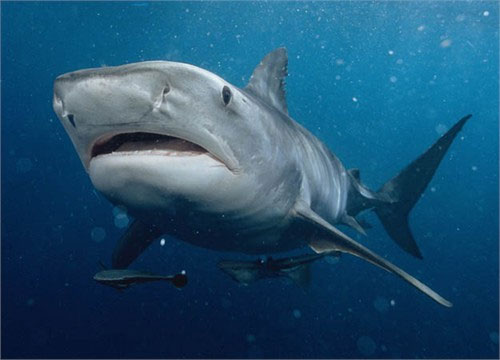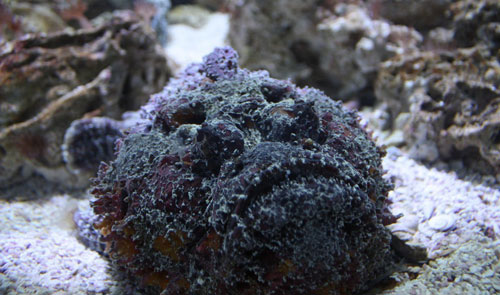The 'monsters' in the sea
If the ground is the dominant area of humanity, the sea is the place where many terrors are feared for humanity because this is the land of big, ferocious and venomous "monsters".
Deep sea "monsters"
Tiger sharks

Normally, humans only pay attention to white sharks, but in fact, tiger sharks are the most dead creatures.
Tiger sharks can eat anything from fish, seals, birds, squid, small sharks, dolphins, sea cars and old car tires. Their bodies grow rapidly and weigh up to 1 ton, 5.5m long.
They live mainly in cold and tropical waters, especially in the central Pacific islands.
Rock fish

Rock fish is the most dangerous venom carrier in the world. They are players in disguise, hiding in stone floors at the bottom of the sea, making prey unable to detect their presence because they look no different from rocks now.
Although fighting fish does not attack humans, we should not step on them. Because thorns throughout the body are specialized for self-defense and fighting against sharks and many other opponents will cause injury to humans. In addition, their venom can cause temporary paralysis and even death if not treated promptly.
Puffer fish

Puffer fish carrying tetrodotoxin is stronger than cyanide / cyanure (toxic substance inhibits aerobic respiration at the cellular level and prevents oxygen consuming cells).
Only the top trained Japanese chefs can successfully cook puffer fish dishes but so far it is still considered "death food".
However, puffer venom is quite useful when scientists are experimenting to relieve symptoms of addiction like herion addiction.
Sea snake

People always feel afraid of venom of snakes. However, the truth is that sea snakes do not have venom like those living on the ground, so they are completely harmless to humans.
Sea urchin fish

Sea urchin fish stand out with a spiky body that contains venom. Although it cannot be fatal to humans, but when accidentally stepped on, the venom will seep into the wound, causing people to feel headache, nausea, and difficulty breathing.
Usually the wound is only swollen and painful for up to 1 hour but the feeling of pain and numbness can last for weeks.
Crocodile

Famous saltwater crocodile is one of the formidable opponents in the world of predators.
With a body length of more than 6m, and weighing up to nearly 1,400kg, they can hunt big prey like monkeys, kangaroo, buffalo and even sharks.
Thanks to their large, sharp teeth, they easily submerge large prey like water buffaloes under water to re-feed and sometimes humans are also victims. Initially, they used large teeth to bite their prey and slowly use their body force to twist their prey to death.
Stingray

With the death of "crocodile hunter" - Steve Irwin in 2006, stingrays have become the name given to the list of the most dangerous sea monsters.
The tail of the stingray may be longer than 20cm and when it feels dangerous close to the tail, it will be stiffer, sharper like a meat cutter and inject a deadly poison that causes the enemy to fall.
According to the Mote Marine Laboratory (US), toxins in stingrays can form large wounds on mammalian bodies, affecting their heart rate and airways.
Sea lion

Sea lions are considered lovely animals, trained to be pastimes in the zoo but they still have the ability to bite people.
In 2006, two sea lion attacks on humans were reported. According to investigators, the possibility of sea lions in California and San Francisco has unfortunately eaten the algae that contain toxins, causing them to have behavioral disorders.
San Diego city officials also warned people that like wild animals, seals and sea lions could suddenly become fierce and with sharp teeth they could still attack humans.
Moray eel

With the shape of eel, Moray eel is 2.4m long, with its mouth protruding out front and wide jaws. Normally, prey will be deceived by looking like corpses lying underneath the sea floor.
With sharp teeth shaped like saw blades, Moray eels destroy enemies with heavy injuries and also Moray eel bacteria causing wound infection. However, if a false attack is detected, Moray eel will quickly release the prey.
Usually during the day, they crawl in cavities and only hunt at night. They can eat whatever creatures and fish they encounter.
- The reason people always like to watch stories about sea monsters
- The most frightening 'monsters' in Russian legends
- The monsters in the lake make humans terrified
- Sea monsters really exist?
- Video: A close-up of terrifying sea monsters
- Search for traces of 3 giant monsters on Earth: The scientific world cannot ignore it
- Fossils suspected of being evidence of monsters eating whales
- Jurassic fossils discovered Jurassic sea 10m long
- These are 5 prehistoric monsters that deserve to be filmed like Megalodon
- The mystery has not been answered about the giant humanoid sea monster in Antarctica
- Photos of 'alien monsters' under the sea have returned and horror than before
- Scary aquatic monsters in New Zealand and the results of the study surprised many people
 Surprised: Fish that live in the dark ocean still see colors
Surprised: Fish that live in the dark ocean still see colors Japan suddenly caught the creature that caused the earthquake in the legend
Japan suddenly caught the creature that caused the earthquake in the legend A series of gray whale carcasses washed ashore on California's coast
A series of gray whale carcasses washed ashore on California's coast Compare the size of shark species in the world
Compare the size of shark species in the world